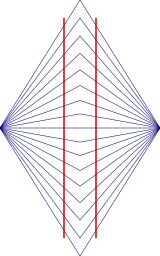
Wundt illusion
Encyclopedia

Optical illusion
An optical illusion is characterized by visually perceived images that differ from objective reality. The information gathered by the eye is processed in the brain to give a perception that does not tally with a physical measurement of the stimulus source...
that was first described by the German psychologist Wilhelm Wundt
Wilhelm Wundt
Wilhelm Maximilian Wundt was a German physician, psychologist, physiologist, philosopher, and professor, known today as one of the founding figures of modern psychology. He is widely regarded as the "father of experimental psychology"...
in the 19th century. The two red vertical lines are both straight, but they may look as if they are bowed inwards to some observers. The distortion is induced by the crooked lines on the background, as in the Orbison illusion
Orbison illusion
The Orbison illusion is an optical illusion that was first described by the psychologist William Orbison in 1939. The bounding rectangle and inner square both appear distorted in the presence of the radiating lines. The background gives us the impression there is some sort of perspective. As a...
. The Hering illusion
Hering illusion
The Hering illusion is a one of the geometrical-optical illusions and was discovered by the German physiologist Ewald Hering in 1861 . Two straight and parallel lines look as if they were bowed outwards. The distortion is produced by the radiating pattern and was ascribed by Hering to an...
produces a similar, but inverted effect.
Another variant of the Wundt illusion is the Horizontal-Vertical Illusion, introduced by Wundt on 1858. The two intersecting lines are equal in length although the vertical line appears to be much longer. The horizontal line needs to be extended up to 30% to match the perceptual length of the vertical line. This is not confined to simple line drawings, as this can also be seen in buildings, parking meters, as well as other things viewed in a natural setting.

